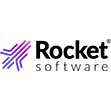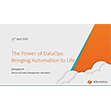
The Cure for Kubernetes Storage Headaches: Break Your Data Free

(Khing Choy/Shutterstock)
If you’re using Kubernetes, there’s likely a simple reason why: Because it makes your life easier. That is, after all, the whole premise behind container-based orchestration. Infrastructure becomes disposable. Spin it up when you need it, throw it away when you’re done, and let Kubernetes worry about the underlying infrastructure, so you don’t have to think too much about it.
At least, that’s how things are supposed to work. As you know if you’ve actually set up workloads that depend on persistent data, there’s one big asterisk – storage.
As great as Kubernetes is at abstracting away compute and networking infrastructure, it just doesn’t work that way for storage when your apps are stateful and data is persistent. Your application still must know all about the underlying storage infrastructure to find its way to the data you need. And not just the location of that data, but all the other fine-grained considerations (performance, protection, resiliency, data governance, and cost) that come with different kinds of storage infrastructure, that most data scientists don’t want to think about.
Why, in a cloud-native world where we’ve automated away the management of so much underlying hardware complexity, is storage still so painful? Two words: data silos.
As long as we continue to manage data via the different infrastructures it lives on, rather than focusing on the data itself, we’ll inevitably end up juggling islands of storage, with all the headaches that come with them. Fortunately, this is not an intractable problem. By changing the way we think about data management, from an infrastructure-centric to a data-centric approach, we can use Kubernetes to give us what was promised in the first place: making storage SEP (Someone Else’s Problem).
Virtualize Your Data
When the data you need is sprawled across different storage silos, each with its own unique attributes (this-or-that cloud, on-premises, object, high-performance, etc.), there’s just no way to abstract away infrastructure considerations. Someone still has to answer all those questions about performance and cost and data governance to set up your pipeline. (And if that person is an IT admin you call for help, you can bet they cringe every time your name pops up on a ticket. Because they know they’re going to be spending the day wrestling with arcane infrastructure interfaces to wrangle your data across all the different copies and data stores, and there’s no way they’re getting that done before lunch.)
The only way to get rid of that headache—the only way to actually realize the speed and simplicity that Kubernetes is supposed to give you—is by virtualizing your data. Basically, you need an intelligent abstraction layer between your data and all your diverse storage infrastructure. That abstraction layer should let see and access your data everywhere, without having to worry about whether a given infrastructure has the right cost, location, or governance for what you’re doing, and without having to constantly make new copies.
Making this happen is not as difficult as it sounds. The key: metadata. When you can encode all the data requirements, context, or lineage considerations into metadata that follows your data everywhere, then it no longer matters which infrastructure data happens to reside on at any given moment. Now, when you’re setting up a data pipeline, you can work entirely with metadata. And your virtualization layer can use AI/ML to automatically handle all the underlying data management and infrastructure considerations for you.
Capitalize on Infrastructure Abstraction
Once you have your virtualization layer in place, and you’re handing data management via metadata, you can do all sorts of things you couldn’t do before. Things like:
- Eliminate data silos: Now, it doesn’t matter which infrastructure the data you need lives on or where that infrastructure is located. To your application, all those previously siloed storage resources (on-premises, cloud, hybrid, archival) just look like a universal global namespace.
- Access storage resources programmatically: Since you’re dealing in metadata—instead of a dozen different underlying hardware infrastructures—you can now set up your pipeline and access your data via declarative statements: I need this data, with this performance, and that’s all I really care about. The intelligent virtualization layer then goes and makes it happen, without your application (or your overburdened IT admin) needing to tell it exactly how.
- Make data management self-service: Data scientists don’t want to worry about comparing the costs of different storage types, enabling data protection, or making sure they’re meeting security and compliance requirements every time they set up a pipeline. (For that matter, your IT and security teams likely don’t want data scientists making those choices either—unless they like having everything run on the most expensive storage, without proper compliance.) Once you separate management of metadata from data, that all goes away. Storage administrators can set guardrails by configuring basic policy once. Users can then self-service most of their data management needs from then on—without opening a ticket, and without the errors that arise when they’re manually making those calls every time they set up a pipeline.
- Continually enrich your data: When your system supports customizable, extensible metadata, you can now do all sorts of interesting things. For example, you can build recursive processes, where you run data through a system, get some results, add those results back to the metadata, and run the job again. You can begin to build deep contextual understanding of the data around the data. The more that data is processed and used, the richer it becomes for other jobs in the future. And, that intelligence now always lives with that data everywhere, for any other application or data scientist who wants to use it. It’s not restricted to one copy, on one island of storage hidden away somewhere.
Unshackle Your Data
All of these things are possible when you virtualize your data, just because metadata is so much more flexible to work with than siloed storage infrastructures. The storage considerations that used to come with setting up and orchestrating your data pipeline can now just happen for you. Your storage resources become programmable, self-service, and automatically compliant, typically requiring no manual intervention.
All of a sudden, you’re actually living the reality that Kubernetes and software-defined storage was always supposed to deliver. Storage is software-defined, programmable, and consistent across hybrid cloud environments, regardless of the underlying infrastructure. Your data is richer and more flexible. Your IT team no longer keeps a blown-up picture from your ID card on the wall to throw darts at. Most important, you’re spending a lot more of your time actually working with your data—instead of worrying about where it lives.
About the author: Hammerspace Vice President of Product Marketing Brendan Wolfe has a long history of product marketing and product management in enterprise IT from servers to storage. Working with both large companies and startups, Brendan helps bring innovative products to new emerging markets.
Related Items:
The State of Storage: Cloud, IoT, and Data Center Trends
Blurred Storage Lines: Clouds That Appear Like On-Prem
September 18, 2025
- EDB Research Shows 87% of Enterprises Lag in Sovereign AI Adoption
- Zencoder Brings AI Coding to a Billion Users with Universal AI Development Platform
- PingCAP Brings Global Data Leaders Together for TiDB SCaiLE 2025 in California
- Qlik Connect 2026 Set for April 13–15 in Florida
- Domo Selected by Showpass to Deliver Scalable, Real-Time Embedded Analytics Worldwide
- Databricks Launches AI Accelerator Program to Scale the Next Generation of AI Startups
- Kennesaw State Researchers Tackling AI-Generated Fraud to Protect Data Integrity
- Salesforce Deepens Commitment to UK AI Innovation, Increases Investment to $6B
September 17, 2025
- Dynatrace Joins GitHub MCP Registry to Accelerate AI-Powered Developer Innovation
- LogicMonitor Sets New Standard for AI-First Observability with Edwin AI and Expanded Service Intelligence
- NASA Expands Access to Earth Data Through New Metadata Pipelines
- MongoDB Extends Search and Vector Search Capabilities to Self-Managed Offerings
- Gartner Says Worldwide AI Spending Will Total $1.5T in 2025
- Cohesity Extends Cyber Resilience Leadership with New Security Innovations and Partnerships
- Ataccama Opens Registration for FWRD 2025
September 16, 2025
- MongoDB Launches AI-Powered Application Modernization Platform to Reduce Technical Debt and Speed Innovation
- UC San Diego Plays Key Role in National Effort to Build a Fusion Research Data Platform
- NVIDIA Welcomes Data Guardians Network to Its Elite Startup Program
- Acceldata Survey Finds Persistent Gaps in Enterprise AI Data Readiness
- Exabeam and DataBahn Partner to Accelerate AI-Powered Security Operations with Smarter Threat Detection
- Inside Sibyl, Google’s Massively Parallel Machine Learning Platform
- What Are Reasoning Models and Why You Should Care
- Rethinking Risk: The Role of Selective Retrieval in Data Lake Strategies
- The AI Beatings Will Continue Until Data Improves
- Software-Defined Storage: Your Hidden Superpower for AI, Data Modernization Success
- Top-Down or Bottom-Up Data Model Design: Which is Best?
- Beyond Words: Battle for Semantic Layer Supremacy Heats Up
- In Order to Scale AI with Confidence, Enterprise CTOs Must Unlock the Value of Unstructured Data
- What Is MosaicML, and Why Is Databricks Buying It For $1.3B?
- How to Make Data Work for What’s Next
- More Features…
- Mathematica Helps Crack Zodiac Killer’s Code
- GigaOm Rates the Object Stores
- Promethium Wants to Make Self Service Data Work at AI Scale
- Databricks Now Worth $100B. Will It Reach $1T?
- Solidigm Celebrates World’s Largest SSD with ‘122 Day’
- AI Hype Cycle: Gartner Charts the Rise of Agents, ModelOps, Synthetic Data, and AI Engineering
- Data Prep Still Dominates Data Scientists’ Time, Survey Finds
- MIT Report Flags 95% GenAI Failure Rate, But Critics Say It Oversimplifies
- The Top Five Data Labeling Firms According to Everest Group
- Career Notes for August 2025
- More News In Brief…
- Seagate Unveils IronWolf Pro 24TB Hard Drive for SMBs and Enterprises
- Gartner Predicts 40% of Generative AI Solutions Will Be Multimodal By 2027
- DataSnap Expands with AI-Enabled Embedded Analytics to Accelerate Growth for Modern Businesses
- Acceldata Announces General Availability of Agentic Data Management
- Qlik Announces Canada Cloud Region to Empower Data Sovereignty and AI Innovation
- Transcend Expands ‘Do Not Train’ and Deep Deletion to Power Responsible AI at Scale for B2B AI Companies
- Pecan AI Brings Explainable AI Forecasting Directly to Business Teams
- Databricks Surpasses $4B Revenue Run-Rate, Exceeding $1B AI Revenue Run-Rate
- SETI Institute Awards Davie Postdoctoral Fellowship for AI/ML-Driven Exoplanet Discovery
- Deloitte Survey Finds AI Use and Tech Investments Top Priorities for Private Companies in 2024
- More This Just In…







































